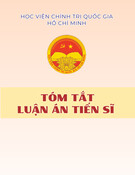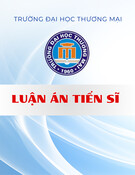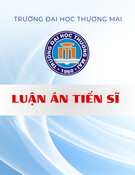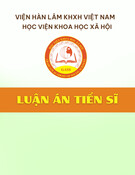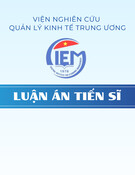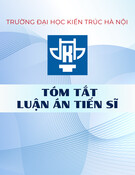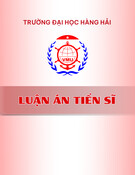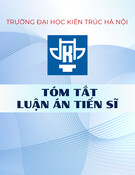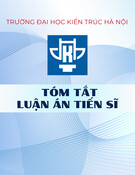
1
INTRODUCTION
1. The urgency of the topic
Sustainable development is not only the process of economic development, the
increase of output volume but also the sustainability of the development, which ensure
the progress in terms of economic structure, society and the balance of ecological
environment.
Today, sustainable development is one of the most important missions of every
country, including Vietnam. In order to monitor the country’s development, Vietnam
has set up a system of statistic index on sustainable development with specific target.
However, the indicators in such a system may have some opposite fluctuation. Some
of them develop well over time, while a few others turn to be worse, affecting the
development process negatively. This situation causes some difficulties in assessing
and analyzing the trend of sustainable development. There have been organizations
and individuals being interested in making aggregate indexes for assessment of
sustainable development so as to obtain a broad overview of this issue. However, up to
date there has been no system with specific recommendations being applied in
practice. This context has encourages the author to work on the thesis “Statistic
Research on Assessment of Sustainable Development in Vietnam”, suggesting a
clear, specific and feasible method to calculate the aggregate index of sustainable
development. The author then used the available data of Vietnam in the period 2001 –
2010 to test the method. This thesis, therefore, contributes in answering the questions
by managers “How to assess the real situation of sustainable development in
Vietnam?” and “How was the reality of Vietnam’s sustainable development in the
period 2001 –2010?”
2. Research objectives
The overall purpose of the thesis is to formulate a method of calculating the
aggregate index for sustainable development so as to implement it in assessing the real
sustainability of development in Vienam. Specifically, the thesis:
- systemizes and clarifies the contents related to sustainable development and
the system of sustainable development index
- suggests a method to calculate individual indicators, component indicators and
2
aggregate index for assessment of sustainable development on the basis of the
available system of indicators in Vietnam
- calculates, on the pilot basis, the aggregate index of sustainable development
in Vietnam in the period 2001 –2010
3. Research targets and methodology
The thesis’ research target is sustainable development.
Research scope:
+ The thesis collect and synthesize data, calculate and analyze aggregate index
of sustainable development in the territory of Vietnam
+ Time target of the research: 10 years from 2001 to 2010, to be suitable to the
10-year strategy for socio-economic development of Vietnam.
The following statistic methods are used for research purposes:
- Desk research. This is one of the method for data collection in sociological
survey. Basing on the secondary data of sustainable development and the way to
calculate the aggregate indexes, the author provides a broad overview of research
target, which later serves as a basis for the later assessment.
- Statistic tables and graphs. They are used to synthesize and demonstrate data
and statistic targets of sustainable development over time.
4. Contribution of the thesis
Through this thesis, the author contributes some new knowledge in terms of
theory and practice of statistic performance, specifically:
First, the thesis formulates a method to calculate an aggregate index of
sustainable development in Vietnam, whereby makes it clear the way to calculate
individual indicators, component indicators and then aggregate index; identifies the
higher bound and lower bound of each indicator. This is a new positive contribution in
term of theory for the future studies in sustainable development in Vietnam.
Second, in term of practice, the thesis gives out analyses and assessments of
sustainability of Vietnam’s development over the period 2001 –2010. The author uses
real data of Vietnam and the above-mentioned formula of calculating aggregate index
on a pilot scheme, analyses the reality of sustainable development in Vietnam over the
past 10 years.
The research results will help Government organizations demonstrate a method

3
to synthesize, assess and compare the sustainability of the country’s development.
Besides, the thesis opens a new direction of perfecting the existing system of statistic
index of sustainable development as well as selects a specific method of assessment in
the coming another 10 years.
5. Structure of the thesis
After the Introduction, which mentions the urgency, objectives, target and
scope of the research, the thesis introduces a research overview. The main literature of
the thesis is divided into 3 parts:
Chapter 1: Overview of sustainable development
Chapter 2: Develop a method to calculate aggregate index for assessing
sustainable development in Vietnam
Chapter 3: Pilot calculation and analysis of aggregate index for assessing
sustainable development in Vietnam in the period 2001 –2010
CHAPTER 1. OVERVIEW OF SUSTAINABLE DEVELOPMENT
1.1.Concepts of development and sustainable development
1.1.1.Development
Development is a popular term used in official documents and daily life. Over
the different stages of historical development, world economic researchers have made
a number of concepts of development.
The concept of development perfects itself along the development of human
society. At present, this concept basically keeps its contents developed in the past
decade but with more emphasis on the human rights. Economic development covers
economic growth, progress in economic structure and social progress.
1.1.2. Sustainable development
The term “sustainable development” came out first in 1980s in the document
Strategy for world conservation published by the International Union for Conservation
of Nature and Natural Resources (IUCN) with a very simple notion –"Human
development is impossible to focus only on economic development, but it should
respect the natural needs of the society and the impacts on ecological environment "
[40, p.18-19].
4
This concept was popularized in 1987 thanks to the Brundtland Report (also
called the Report on Our Common Future) by the World Committee for Environment
and Development (WCED) under the United Nations. The report made it clear that
“sustainable development is the development which can meets the current needs
without negative impacts and damages to the ability to meet the needs of future
generations" [41, p.37].
Sustainable development was known in Vietnam in late 1990s. Basing on the
above concepts and the nation’s real practice, Vietnamese economic researchers
developed the concept of sustainable development as a basis for completing
development targets of the country. They are healthy development, where the one’s
development does not harm others’ benefits, individual development does not damage
the community’s benefits, development of one community does not negatively affect
that of another community, the development of today’s generation does not intervene
the interests of the next generation, and the development of human being does not
threat life or worsen living conditions of other creatures on the planet.
1.2. The necessity for implementation of sustainable development
Everybody in the world would like to perfect his life in order to create magic
development ever seen. However, our Earth with its natural conditions cannot meet
those unlimited expectations of human being. Natural resources are limited, so they
will come to end, natural conditions may become more severe. This create serious
conflicts, which require development in harmony between the people and their
surrounding environment. Therefore, implementation of sustainable development is
considered the top priority of each nation. Organizations and countries, depending on
their various objectives, point out the necessity of developing sustainably and various
contents of sustainable development.
In Vietnam, the issue of sustainable development is made in details in various
political documents, specifically in the Resolutions of the 4th Plenary National
Convention of the Communist Party of Vietnam. According to this Resolution, the 10-
year strategy for socio-economic development should “develop fast, efficiently and
sustainably, achieve economic growth along with accomplishment of social progress
and equality and environment protection”, “create socio-economic development in
close link with environment protection and improvement, ensuring the harmony

5
between man-made environment and natural environment, conserving ecological
diversity.” [36]. In the next 10 years from 2011 to 2020, sustainable development is a
consistent requirement in the Socio-economic Strategy set by CPV in the 11th Plenary
Meeting: “Sustainable development is a basis for fast development, which create
resources for sustainable development in its turn. Fast development and sustainable
development must go together in planning, plans and policies of socio-economic
development " [37].
1.3.Contents of sustainable development
1.3.1.Contents of sustainable development, according to some international
organizations
The Earth Summit on Environment and Development (Rio de Janero 6/1992)
and the ASEM Youth Dialogue on sustainable development agreed that sustainable
development consists of four dimentions, namely economic, social, environmental and
regulatory. Each country should have its regulatory dimension as a basis for the
planning and policy making, as well as the targets to achieve and the communication
for public. Therefore, these two organizations made regulatory dimension equally
important as the three main dimensions which create the sustainable development in
economy, society and environment.
Following another approach, two Canadian environmentalists named Jacobs
and Sadler define sustainable development in its nature as an aggregate and systematic
development. Seeing the relationship between three factors of economy, society and
environment, Jacobs and Sadler form sustainable development with a triagle of these
factors, of which environment is put on top and the factor of regulation is included in
social factor. This model is later developed into a 3-extreme chart by Mohan
Munasingle, a World Bank specialist.
This approach is popularized all over the world today for it is a combination of
the 3 factors with a total force to create the stability and sustainability for each nation.
1.3.2. Vietnam
In 2004, Vietnam established its own sustainable development program called
AGENDA-21. In this program, Vietnam makes its clear overall objective of
sustainable development as “to achieve abundance of materials, richness of culture and
spirit, equality of citizens and consensus of society, harmony between human and
6
nature; to develop in a close, rational and harmonious link of 3 factors including
economic development, social development and environment protection”. This is the
basis for sustainable development on 3 factors of economy, society and environment.
1.4. A system of indicators of sustainable development
1.4.1. Some general issues of the system of statistic index
A system of index is a collection of indicators, which includes not any
indicators but a systematically selected group of indicators to reflect 2 major contents:
the most important aspects and features of population and the basic relationship
between the aspects of population as well as between the studied population and their
related phenomena within the limit of research scope.
To obtain the relevant system of statistic index which can be used to assess the
real situation of development, the system must meet 4 requirements: research
objectives, features reflected, feasibility and number of indicators.
Based on these requirements, the thesis assess the relevance and feasibility of the
system of statistic index for sustainable development applied in Vietnam on a later day.
1.4.2.Studies of statistic index system for sustainable development in the world
In early 1995, to meet the requirement of UN Committee for Sustainable
Development (UN CSD), the UN Committee for Economic and Social Issues in
cooperation with experts from various international organization and other members
established a system of statistic index includind 134 national indicators of sustainable
development.
In 2001, UN CSD introduced a recommended system of statistic index
including 15 major topics, 38 sub-topics and 58 indicators. This system of index was
adjusted one more time in 2006, serving as a basis for nations to establish their own
system of statistic index for sustainable development.
Other organizations under the UN and various social and non-government
organizations also study and introduce their national index e.g. index of human
development, index of eco footstep, etc.
Different nations also introduce strategies for sustainable development
AGENDA-21 together with a system of statistic index for sustainable development
with a large range of indicators and contents, e.g Indonesia (21 indicators), China (80
indicators), UK (15 indicators), USA (32 indicators)...

7
1.4.3.Studies of statistic index system for sustainable development in Vietnam
Along with the world trend Vietnamese researchers have studied to set up its
own system of statistic index for sustainable development. The research process gets
the attention of various ministries, industries and organizations. The results include the
introduction of some systems of index. Over time, the system of statistic index for
sustainable development has been perfected and implemented in real life. With
expectation to have a unanimous system of statistic index, on 12 April 2012, The
Prime Minister signed Decision 432/QĐ-TTg to approve the Vietnam’s Strategy for
Sustainable Development period 2011 - 2020. Pursuant to this decision, the system of
statistic index for supervison and assessment of Vietnam’s sustainable development
period 2011 - 2020 consists of 30 indicators with data sources and implementation
plan as described in Table 1.1.
Table 1.1. System of statistic index for supervision and assessment of
Vietnam’s sustainable development
No.
Indicators
Organization in charge
of collection
Plan
I
Aggregate indicators
1
Green GDP (in VND or USD)
MPI (GSO)
2015
2
Human Development Index (HDI) (0-1)
MPI (GSO)
2015
3
Index on Environment Sustainability (0-1)
MPI (GSO)
2015
II
Economic indicators
4
Efficient use of investment capital (ICOR)
(increase of implemented investment capital
by 1 GDP dong)
MPI (GSO)
2011
5
Labor productivity (USD/worker)
MPI (GSO)
2011
6
Proportion of contribution by productivity
of aggregate factors in overall growth rate
(%)
MPI (GSO)
2015
7
Decrease in energy consumption in
production of 1 GDP unit (%)
MPI (GSO)
2015
8
No.
Indicators
Organization in charge
of collection
Plan
8
Proportion of recycle energy in the energy
consumption structure (%)
Ministry of Trade and
Industry
2011
9
Consumption Price Index (CPI) (%
compared with the last December)
MPI (GSO)
2011
10
Current Balance (bil. USD)
State Bank
2011
11
State deficit (%/GDP)
Ministry of Finance
2011
12
Sovereign Debt (%/GDP)
Ministry of Finance
2011
13
Foreign Debt (%/GDP)
Chairing: Ministry of
Finance
2011
Cooperating: State Bank
III
Social Indicators
14
Rate of Poverty (%)
MPI (GSO)
2011
15
Rate of Unemployement (%)
MPI (GSO)
2011
16
Rate of trained employees working in the
economy (%)
MPI (GSO)
2011
17
Coefficient of inequality in income
distribution (Gini coefficient) (times)
MPI (GSO)
2011
18
Gender Ratio at birth (boys/100 girls)
Ministry of Health
2011
19
Number of students/10.000 people
(students)
Ministry of Education
and Training
2011
20
Number of Internet subscribers
(subscribers/100 people)
Ministry of Information
and Communication
2011
21
Rate of population benefitted from social,
health and unemployment insurance (%)
Viet Nam Social
Security
2011

9
No.
Indicators
Organization in charge
of collection
Plan
22
Number of death by traffic accidents
(people/100.000 people/year)
Ministry of Police
2011
23
Rate of villages recognized to meet criteria
of new rural community (%)
Ministry of Argriculture
and Rural Development
2015
IV
Indicatiors of environment and natural
resources
24
Rate of forest coverage (%)
Ministry of Argriculture
and Rural Development
2011
25
Rate of land areas protected and maintaining
bio- diversity (%)
Ministry of Environment
and Natural Resources
2011
26
Area of deteorated land (mil. ha)
Ministry of Environment
and Natural Resources
2015
27
Decrease of underground and surface water
volume (m3/person/year)
Ministry of Environment
and Natural Resources
2011
28
Rate of days with high level of toxicated air
exceeding the accepted level (%)
Ministry of Environment
and Natural Resources
2011
29
Rate of urban areas, industrial and
processing zones and industrial clusters with
standardized processing of solid wastes and
waste water to meet relevant national
standards and technical requirements (%)
- Chairing: Ministry of
Construction
2011
- Cooperating: Ministry
of Environment and
Natural Resources;
Ministry of Trade and
Industry
30
Rate of solid waste collected and processed
to meet relevant national standards and
technical requirements (%)
- Chủ trì: Ministry of
Construction
2011
- Phố i hợ p: Ministry of
Environment and Natural
Resources
(Source:Decision 432/QĐ-TTg dated 12 April 2012 by the Prime Minister)
10
CONCLUSION OF CHAPTER 1
Chapter 1 presents an overview of sustainable development, including concepts,
necessity and major contents. Sustainable development is a firm combination and
inter-relations between economic development and social issues and environment
factors in harmony, stability and flexibility. These factors present an urgent priority to
every nations, including Vietnam.
Contents of sustainable development concentrate in three areas of economy,
society and environment, which should be equally treated. These contents are bases for
developing a system of statistic index for sustainable development in the world and in
Vietnam as well. From this suggestion Chapter 1 introduces some available systems of
statistic index for sustainable development analyses in depth the current system of
statistic index for sustainable development of Vietnam. This is the latest system
introduced by the Government, with presence of some aggregate indicators to give
assessment of various aspects.
The later part of the Chapter analyzes the similarity and difference of Vietnam’s
system of statistic index for sustainable development and the system recommended by
the UN Council for sustainable development. Besides, the author points out some
limitations in the system to address in the coming time.
In the recommended system of statistic index the assessment will be
implemented on separated indicators, which reflect each and every dimension of
sustainable development. However, if stopping at that point, the thesis cannot come up
with an overall conclusion on the results of sustainable development in the country.
There should be an assessment on the process of sustainable development over time to
compare and withdraw experience for development. Right here is the gap in both
theory and practice calling for further research in this thesis.

